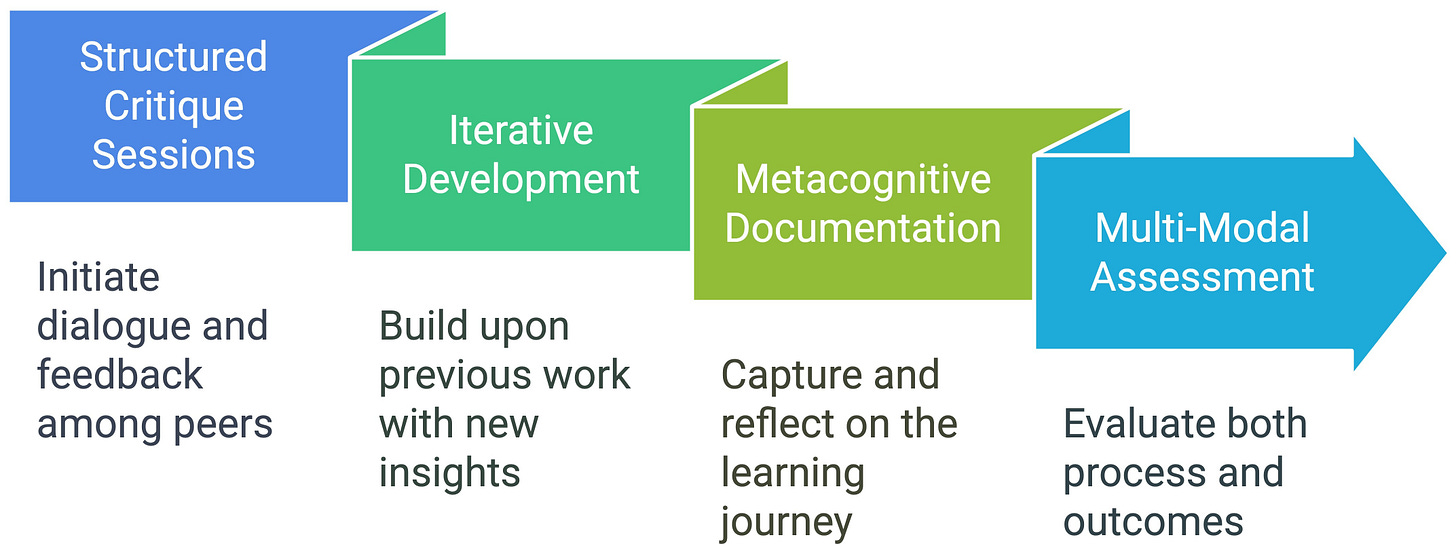As an educator navigating the rapidly evolving landscape of AI-enhanced learning, I’ve been grappling with a fundamental question: How do we preserve meaningful human agency in education while embracing the capabilities of AI? The answer, I propose, lies in what I call the Process-Centered Critique Model (PCM), a comprehensive framework that adapts design critique methodology for universal pedagogical use.
As both a researcher and educator at Drexel University, I’ve observed firsthand how AI systems are disrupting traditional educational paradigms. These systems can now generate sophisticated essays, solve complex problems, and create polished work with remarkable proficiency. This capability, while impressive, risks obscuring what matters most in education - the thinking process itself. When students can easily generate seemingly perfect outputs with AI, how do we ensure they’re truly engaging with the material and developing critical thinking skills?
The PCM framework, which emerged from my research into educational innovation, offers a structured approach to this challenge. Drawing inspiration from design education, where critique has long been a cornerstone of learning, I’ve developed a model that could transform how we teach across all disciplines. In this article, I want to share the fundamental principles of this framework.
The Four Pillars of the Process-Centered Critique Model
At its heart, PCM comprises four interconnected components that work together to make student thinking visible and assessable.
First, structured critique sessions serve as the primary vehicle for learning. Unlike traditional presentations, these sessions require students to articulate their thinking process, explain their decisions, and engage in meaningful dialogue about their work-in-progress.
The second pillar, iterative development, ensures deep engagement through multiple rounds of refinement. Each iteration builds upon previous work while incorporating new insights and understanding. This approach transforms learning from a linear process into a dynamic journey of continuous improvement.
Metacognitive documentation forms the third component, capturing the learning journey through detailed process records. Students maintain decision logs that articulate key choices and their rationale, creating a rich record of their intellectual development. This documentation not only makes thinking processes visible but also helps students develop self-awareness about their learning.
Finally, multi-modal assessment evaluates both process and outcomes using diverse evaluation methods. This comprehensive approach ensures we’re assessing not just what students produce, but how they think and develop over time.
Beyond Creative Disciplines
While critique-based learning might seem most natural in creative fields, I’ve found its principles apply remarkably well across disciplines. The framework has proven particularly powerful in technical courses where problem-solving processes are often hidden in the final products.
In my field of digital media and game development, for example, PCM encourages students to engage in a systematic process of documenting and critiquing their work at every stage. In doing so, they present not just the code or visual elements of their creation, but their entire decision-making process from initial concept sketches through multiple iterations of functionality testing and user feedback integration.
The beauty of PCM lies in its ability to make thinking processes visible and assessable while maintaining academic rigor. The framework offers concrete ways to cultivate critical thinking, creativity, and professional judgment across engineering, the humanities, and the sciences. In each case, the key lies not in the produced artifact but in the documented journey of how students arrived at their solutions and how they incorporated feedback at each stage of development.
Embracing AI While Preserving Human Agency
Perhaps most importantly, PCM offers a way to integrate AI tools thoughtfully while ensuring meaningful human learning. When students must articulate their thinking process, defend their choices, and engage in a substantive dialogue about their work, they develop capabilities that AI cannot replicate. The framework encourages students to use AI as a tool while maintaining their agency as learners and thinkers.
Looking ahead, I see PCM as more than just a teaching methodology - it’s a way to reimagine education for an AI-enhanced world. By making the learning process explicit, assessable, and adaptable, we can foster creativity, critical thinking, and authentic engagement while leveraging the benefits of AI tools.
It has to be noted that the journey of implementing PCM isn’t without its challenges. It requires careful planning, faculty development, and institutional support. But as I witness my students developing deeper understanding and more sophisticated thinking skills, I’m convinced it’s a path worth pursuing.
Acknowledgment
The Process-Centered Critique Model will be presented in detail in a research paper at INTED2025, the 19th annual International Technology, Education and Development Conference, taking place in Valencia, Spain from March 3-5, 2025. The presentation at INTED2025 will also explore the theoretical foundations and practical implementations of PCM.





